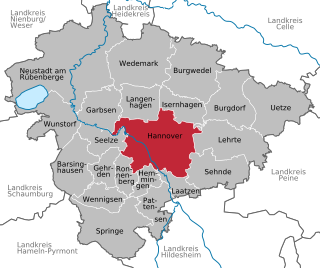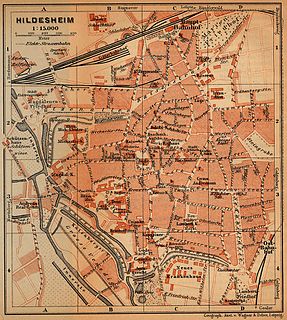
The Church of St. Michael is an early-Romanesque church in Hildesheim, Germany. It has been on the UNESCO World Cultural Heritage list since 1985. It is now a Lutheran church.

Hildesheim Cathedral, officially the Cathedral of the Assumption of Mary or simply St. Mary's Cathedral, is a medieval Roman Catholic cathedral in the city centre of Hildesheim, Germany, that has been on the UNESCO World Cultural Heritage list since 1985, together with the nearby St. Michael's Church.

Saint Bernward was the thirteenth Bishop of Hildesheim from 993 until his death in 1022.

Klein Düngen is a village in the northern part of the borough of Bad Salzdetfurth in Lower Saxony, Germany. Klein Düngen is on the river Lamme, a tributary of the River Innerste. The Lamme Valley Railway passes the village, but the nearest railway station is in Groß Düngen, a larger village in the west.
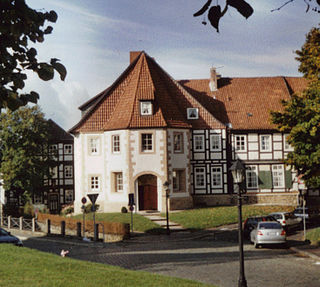
St. Nicholas' Chapel is a former Roman Catholic parish church in the city of Hildesheim in Lower Saxony, Germany. It is dedicated to Saint Nicholas and is located in the southern part of the old city centre, opposite St. Godehard.
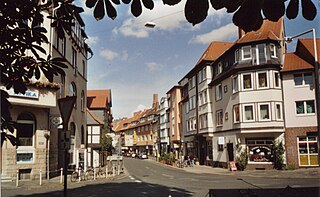
Moritzberg is a quarter in the city of Hildesheim in Lower Saxony, Germany. It is on a hill in the west of the city, about a mile from the Cathedral. It was an independent market town until 1911.

St. Lamberti is a parish and church in Hildesheim, Germany, the parish of the town's Neustadt. It is named after Lambert of Maastricht, the patron saint of Hildesheim. The church is a late Gothic building, the only hall church of the town. Since the Reformation, it has been a Lutheran parish church. It is situated in the Goschenstraße, on the Neustädter Markt.

The term Cross of Bernward principally refers to two Ottonian crosses in the cathedral museum in Hildesheim:

The Hezilo chandelier is an 11th-century Romanesque wheel chandelier. It is part of the treasures of the Hildesheim Cathedral in Hildesheim, Germany, which has been a UNESCO World Cultural Heritage site since 1985. The chandelier was most likely commissioned by Bishop Hezilo of Hildesheim, who rebuilt the cathedral after a fire. He probably also influenced the program of imagery and inscriptions. It is the largest of four extant wheel chandeliers of the period; the others surviving examples are the Azelin chandelier, the Barbarossa chandelier in the Aachen Cathedral, and the Hartwig chandelier in the Abbey of Comburg.

The Azelin chandelier is a Romanesque wheel chandelier, made in the 11th century for the Hildesheim Cathedral in Hildesheim, Germany, a UNESCO World Cultural Heritage site since 1985. It is the oldest of four extant wheel chandeliers from that period, along with the Hezilo chandelier, also in Hildesheim, the Barbarossa chandelier in the Aachen Cathedral, and the Hartwig chandelier in the Abbey of Comburg. It was believed to be donated by Bishop Azelin, however his predecessor Thietmar is more likely to be the patron. Therefore, the chandelier is also called the Thietmar chandelier (Thietmarleuchter).

The Bernward Doors are the two leaves of a pair of Ottonian or Romanesque bronze doors, made c. 1015 for Hildesheim Cathedral in Germany. They were commissioned by Bishop Bernward of Hildesheim (938–1022). The doors show relief images from the Bible, scenes from the Book of Genesis on the left door and from the life of Jesus on the right door. They are considered a masterpiece of Ottonian art, and feature the oldest known monumental image cycle in German sculpture, and also the oldest cycle of images cast in metal in Germany.

The Bernward Column also known as the Christ Column is a Romanesque bronze column, made c. 1000 for St. Michael's Church in Hildesheim, Germany, and regarded as a masterpiece of Ottonian art. It was commissioned by Bernward, thirteenth bishop of Hildesheim. It depicts images from the life of Jesus, arranged in a helix similar to Trajan's Column: it was originally topped with a cross or crucifix. During the 19th century, it was moved to a courtyard and later to Hildesheim Cathedral. During the restoration of the cathedral from 2010 to 2014, it was moved back to its original location in St. Michael's, but was returned to the Cathedral in August 2014.

St. Godehard is a Romanesque church in Hildesheim, Germany, formerly the church of a Benedictine abbey. It remained almost unaltered through the centuries and was not damaged much in World War II. In 1963, it was awarded the title of a Basilica minor by Pope Paul VI. It is a church of the Catholic parish Heilig Kreuz. The basilica has served as the "cathedral" of the bishop of Hildesheim from 1945 to 1960, when the Hildesheim Cathedral was destroyed and rebuilt, and from 2010, when restoration of the cathedral began. The Hezilo chandelier was installed in St. Godehard during the restoration time.

The Hildesheim Cathedral Museum is the Schatzkammer (treasury) and diocesan museum of Hildesheim, which illustrates over a thousand years of art and church history in Lower Saxony. It is located in historic rooms off the southern transept of the Hildesheim Cathedral. During the cathedral renovations of 2010, the nearby church of St Antonius and part of the cathedral cloisters were converted into display rooms for the museum.
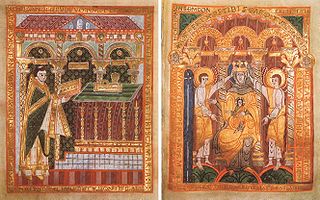
The Rich Bernward Gospels are a richly decorated evangeliary in the Hildesheim Cathedral Museum. It was a donation of Bernward, Bishop of Hildesheim, to his foundation St. Michael's, specifically for the altar to Mary in the crypt below the west choir, which was consecrated in 1015 and which he had designated as his tomb.
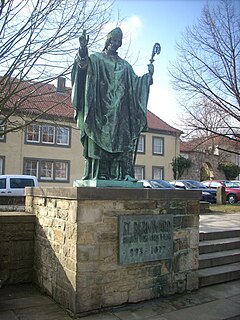
The Bernward Monument is a larger-than-life-sized bronze statue of Bishop Bernward of Hildesheim in the Domhof in Hildesheim. It was made by Ferdinand Hartzer in 1893 for the nine hundredth anniversary of St. Bernward's enthronement as Bishop of Hildesheim. On 7 September 2011, in the course of the renovations of Hildesheim Cathedral it was temporarily relocated to the garden of house 24, Domhof.

The Great Gandersheim Conflict was a conflict between the Archbishops of Mainz and the Bishops of Hildesheim concerning the jurisdiction over Gandersheim Abbey. It lasted from 987 to 1030, during the reign of the Ottonian emperors Otto III and Henry II as well as of their Salian successor Conrad II.
Justus Wehmer was a German master builder of the Baroque era. He was the architect of the eighteenth century Hildesheim Cathedral and surrounding buildings. He was also responsible for the design of various town houses and manor houses in Westphalia.







